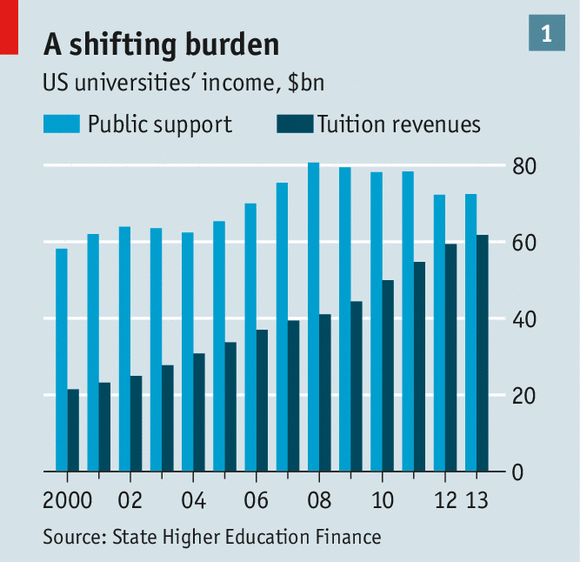Writing in the New York Times yesterday, my University of Colorado colleague Paul Campos, a professor of law, makes the decidedly contrarian argument that decreasing state subsidies are not the primary factor in the increasing costs of tuition.
Campos writes:
Once upon a time in America, baby boomers paid for college with the money they made from their summer jobs. Then, over the course of the next few decades, public funding for higher education was slashed. These radical cuts forced universities to raise tuition year after year, which in turn forced the millennial generation to take on crushing educational debt loads, and everyone lived unhappily ever after.Campos concludes:
This is the story college administrators like to tell when they’re asked to explain why, over the past 35 years, college tuition at public universities has nearly quadrupled, to $9,139 in 2014 dollars. It is a fairy tale in the worst sense, in that it is not merely false, but rather almost the inverse of the truth.
What cannot be defended, however, is the claim that tuition has risen because public funding for higher education has been cut.Campos, I am afraid is wrong. Badly wrong. His major error is to confuse the price of tuition with the costs of delivering a college education. Let me explain.
First, it is important to distinguish between the cost of delivering a college education and the price of tuition. At US public universities, the cost equals the price of tuition plus a state subsidy. Tuition is the price that the student of their family pays to attend college. So what has happened to state subsidies? They have gone down, almost everywhere.
The graph below, from the Center on Budget and Policy Priorities, shows the deep cuts that have been made by state governments in terms of a per-student subsidy.
For a given cost, if the state subsidy goes down, then the tuition necessarily must go up to compensate. And the data shows this is exactly what has happened. Here is overall national data:
Tuition revenue more than doubled from 1987 to 2012. And here are the absolute numbers courtesy of the Economist:
But let's get more specific and look at costs, the state subsidy and tuition at the University of Colorado where Campos and I are both professors. Here is some specific data for the University of Colorado:
Here are the details (from this post):
- In 2001-2002 in-state tuition was $2,614 and the state provided a $7,063 subsidy per student, for a total of $9,677, or after factoring in inflation, $12,289 in 2011 dollars.
- In 2011-2012 in-state tuition was $7,672 and the state provided a $2,839 subsidy per student, for a total of $10,511.
The University of Colorado became more efficient from 2001 to 2001 in that the overall cost-per-student of delivering an education dropped by about 15% per student. Maybe, as Campos alleges, there are more administrators with swanky salaries. Even so, the cost of delivery of an education went down. Perhaps that is not true at every university,
Yet, at the same time, tuition -- as seen by the student and their family -- almost tripled.
Campos is likely correct that overall public money to higher education has increased over recent decades (certainly true if R&D spending is included). But that is utterly irrelevant to the question why the price of tuition has increased. Tuition is a cost born by the individual student, and is a function or more variables than just the overall spending on higher education.
The data show clearly, and I think irrefutably, that the pull-back in state subsidies for students attending public universities has led to an increase in the price of tuition. No doubt there are also market factors at play (e.g., the salaries of professors and administrators) and institutional factors (e.g., infrastructure, operations, and yes, the size of administrative budgets). But as the University of Colorado example shows, the overall cost can be reduced, yet tuition can go up dramatically.
So when Campos concludes that "the claim that tuition has risen because public funding for higher education has been cut.... flies in the case of facts," he is looking at the wrong facts in the wrong way. The pull back in state funding is indeed a primary driver in the increased costs of tuition.




